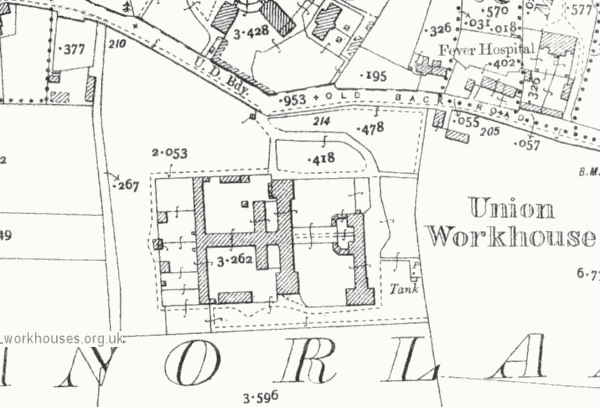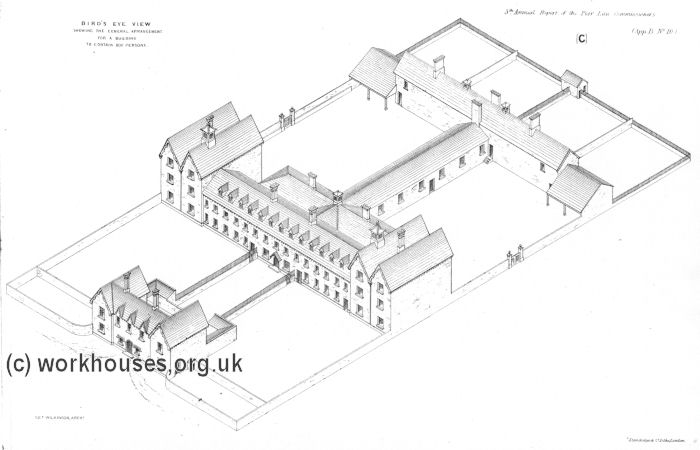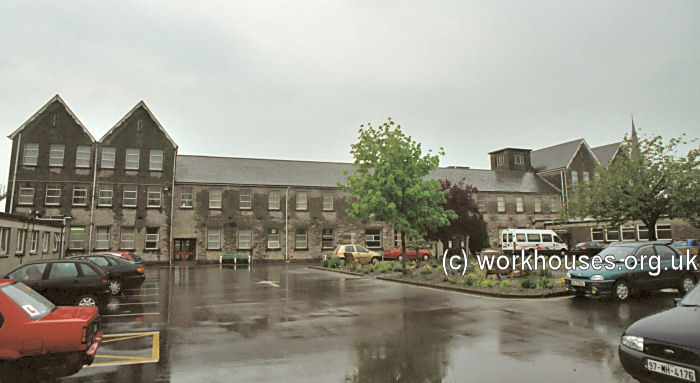County Home, Trim, Co. Meath, Republic of Ireland
The Trim County Home had its roots in the Trim Union Workhouse, erected in 1840-1 on a six-acre site on Patrick Street, Trim. Like almost all Irish workhouses, the original buildings were designed by George Wilkinson. There was an entrance block at the east of the site, later extended to the south. The main accommodation block had the Master and Matron's's quarters at the centre, with male and female wings to each side. A single-storey range containing the kitchen and laundry then linked via the dining-hall and chapel to the infirmary and 'idiots wards' at the rear of the complex. The buildings were intended to accommodate up to 500 inmates.
The Trim workhouse site is shown on the 1912 map below.

Trim workhouse site, Trim, c.1912.

George Wilkinson's model Irish workhouse design. © Peter Higginbotham

Former Trim workhouse main building, 2002. © Peter Higginbotham
In 1884, a convent was built at the site to house the Sisters of Mercy who were providing the nursing staff in the workhouse infirmary.
Following the creation of the Irish Free State in 1921, the Boards of Guardians that had administered each union area were abolished and the government appointed commissioners to overhaul the existing poor relief system and formulate a county-based plan for its future administration and operation. Boards of Public Assistance and Boards of Health were formed in each county and the existing workhouse sites allocated to new roles. In most cases, the main building in one of the county's former workhouses was adopted as a County Home, accommodating the elderly poor and infirm, the disabled, and people with various mental conditions, referred to at that time as 'lunatics', 'idiots' and 'imbeciles'. County Homes were frequently also used to house unmarried mothers and their children, and some admitted orphaned or abandoned children. Many former workhouse infirmaries, fever hospitals and other medical facilities were redesignated as County, District, Cottage or Fever Hospitals. The county schemes were formalised by Local Government (Temporary Provisions) Act of 1923. In County Meath, the Trim workhouse became the Trim County Home.
A report on the Meath County Scheme in 1927 recorded:
In January 1931, an inquest was held at the home into the death of a 16-day-old infant, the son of Mary Farrelly, from Kells. The nurse in charge of the home's maternity hospital, Helen Brennan, testified that it had apparently been a healthy child and given good care by its mother. However, as she had seemed somewhat clumsy in handling the baby, she had been given special supervision for a few days. On 6 January, the nurse had returned from Mass to the ward, where Farrelly and six other women had been left in their beds. The mother had handed her the baby's body which was cold and partly stiff, and its head and face dark blue. Medical evidence was presented to indicated that the baby had died from asphyxia, the result of suffocation. It was also stated that the mind of the mother was all right. The inquest jury unanimously found that no-one was to blame and exonerated the mother. At a subsequent criminal trial, the jury heard that despite publicity about the dangers of allowing newly born babies to sleep with their mothers, this is what had happened at the home, in a single bed that was no more than three feet wide. The judge told the jury that with so many elements of doubt it would be dangerous to bring in a verdict of guilty. The jury returned a no guilty verdict and the prisoner was discharged.
In August 1948, a meeting of the Meath County Council discussed the state of the County Home building. The County Manager said that there were four different classes in the home: old age and infirm; those suffering from chronic illnesses; mental defectives, and unmarried mothers and their children. Councillor Henry said that although a large amount of money had been spent on the institution in recent years, it was not up to the requirements of the standard of the time. He believed that unmarried mothers and mental defectives should not be in the home but catered for on a regional basis.
In 1951, the county councils of Meath, Westmeath, Cavan, Longford, and Louth formed a consortium to open a new mother and baby home, which opened at Dunboyne in 1955. The Trim County Home then stopped being used for this purpose.
By 1960, the county home site had been renamed Joseph's Hospital, which still occupies the site. Only the workhouse main building survives.
Records
Note: many repositories impose a closure period of up to 100 years for records identifying individuals. Before travelling a long distance, always check that the records you want to consult will be available.
- Meath County Library, Railway Street, Navan, Co. Meath.
Bibliography
- Nicolson, Jill Mother and Baby Homes: a survey of homes for unmarried mothers (1968, Allen & Unwin)
- Redmond, Paul Jude he Adoption Machine: The Dark History of Ireland's Mother and Baby Homes and the Inside Story of How Tuam 800 Became a Global Scandal
Links
Except where indicated, this page () © Peter Higginbotham. Contents may not be reproduced without permission.


